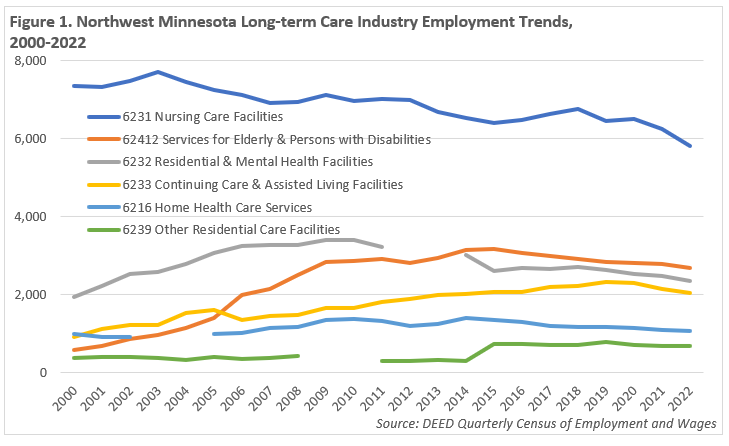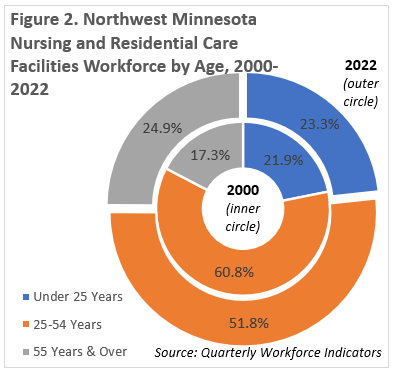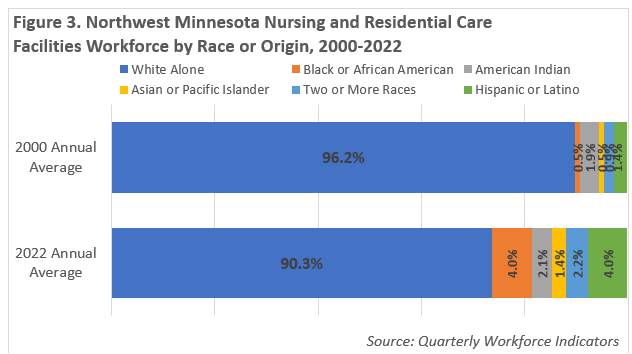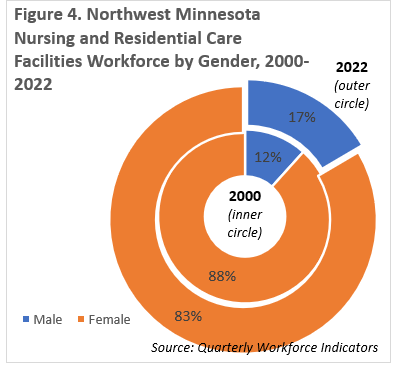by Anthony Schaffhauser
October 2023
Long-term care is defined by the U.S. Dept. of Health and Human Services as a range of services and supports that people may need to meet their personal care needs. Most long-term care is not medical care, but rather assistance with the basic personal tasks of everyday life. This includes care to people who have a chronic illness or disability and can be provided at home, in the community, in assisted living or in nursing homes.
Traditionally many older people or people with disabilities have depended on the services of a skilled nursing home facility, where they receive around-the-clock help with daily living activities and care needs. Even as the state and region's population has grown older, however, nursing care facilities have actually seen a decline in employment over the last decade, as both consumers and the state and federal government embrace alternatives to nursing homes.
Family members provide the majority of long-term care outside nursing care facilities, but those needing the care do not always have someone to depend on or have increasing needs that become too much to handle. This leads to a growing portion of long-term care being purchased from professional or paraprofessional service providers. In response to this shift, services for the elderly and disabled, home health care, and community care facilities have been and are projected to continue to be among the fastest growing sectors in the entire region.
In Northwest Minnesota nearly 14,600 jobs in long-term care industries are spread across Services for the Elderly and Persons with Disabilities, Residential Intellectual and Developmental Disability, Mental Health and Substance Abuse Facilities; Continuing Care Retirement Communities and Assisted Living Facilities, Home Health Care Services, Other Residential Care Facilities, and most importantly, Nursing Care Facilities, which had 5,805 jobs in 2022 (see Table 1).
| Table 1. Northwest Minnesota Industry Employment Statistics, 2022 Annual Average | ||||||
|---|---|---|---|---|---|---|
| NAICS Code | NAICS Industry Title | Number of Firms | Number of Jobs | Avg. Annual Wages | Change in Jobs, 2000-2022
Number | Percent |
|
| 0 | Total, All Industries | 18,083 | 221,652 | $49,379 | 19,706 | .8% |
| 62 | Health Care and Social Assistance | 1,868 | 38,251 | $54,425 | 9,438 | 32.8% |
| 6216 | Home Health Care Services | 38 | 1,055 | $33,659 | 78 | 8.0% |
| 623 | Nursing and Residential Care Facilities | 352 | 10,843 | $37,273 | 289 | 2.7% |
| 6231 | Nursing Care Facilities (Skilled Nursing Facilities) | 64 | 5,805 | $40,587 | -1,550 | -21.1% |
| 6232 | Residential Intellectual and Developmental Disability, Mental Health and Substance Abuse Facilities | 136 | 2,341 | $35,474 | 420 | 21.9% |
| 6233 | Continuing Care Retirement Communities and Assisted Living Facilities for the Elderly | 101 | 2,029 | $31,441 | 1,117 | 22.5% |
| 6239 | Other Residential Care Facilities | 52 | 668 | $32,486 | 303 | 83.0% |
| 62412 | Services for the Elderly and Persons with Disabilities | 435 | 2,685 | $23,818 | 2,125 | 379.5% |
| Source: DEED Quarterly Census of Employment and Wages | ||||||
As noted earlier, employment at Nursing Care Facilities has dropped rapidly over the past two decades, losing -1,550 jobs from 2000 to 2022. That is in contrast to all other long-term care subsectors, which saw rapid growth in the last 22 years, including nearly five-fold job expansion in Services for the Elderly & Persons with Disabilities and doubling in Continuing Care Retirement Communities and Assisted Living Facilities.
While employment had been declining throughout the past two decades at Nursing Care Facilities, it's important to note that they suffered almost half of that total job loss since 2020 as the COVID-19 pandemic wreaked havoc on the industry. Likewise, the rest of the long-term care-related sectors also lost workers from 2020 to 2022. Even as many other industries across the rest of the economy started to recover and add jobs from 2021 to 2022, all the long-term care sectors continued to cut jobs in the region (see Figure 1).

Despite these short-term losses, according to DEED's Employment Projections data the entire Health Care and Social Assistance industry is projected to gain about 4,500 net new jobs in the 26-county Northwest Minnesota planning region from 2020 to 2030, accounting for over 35% of total job growth in the region. More specifically, over 700 of those jobs are expected to be added in long-term care-related subsectors (see Table 2).
| Table 2. Northwest Minnesota Industry Employment Projections, 2020-2030 | |||||
|---|---|---|---|---|---|
| NAICS Code | Industry | Estimated Employment 2020 | Projected Employment 2030 | Percent Change 2020-2030 | Numeric Change 2020-2030 |
| 0 | Total, All Industries | 250,722 | 263,441 | 5.1% | 12,719 |
| 62 | Health Care and Social Assistance | 36,901 | 41,390 | 12.2% | 4,489 |
| 6216 | Home Health Care Services | 1,031 | 1,252 | 21.4% | 221 |
| 623 | Nursing and Residential Care Facilities | 11,313 | 11,803 | 4.3% | 490 |
| 6231 | Nursing Care Facilities | 5,889 | 5,794 | -1.6% | -95 |
| 6232 | Residential Mental Health Facilities | 2,514 | 2,635 | 4.8% | 121 |
| 6233 | Community Care Facilities for the Elderly | 2,228 | 2,663 | 19.5% | 435 |
| 6239 | Other Residential Care Facilities | 682 | 711 | 4.3% | 29 |
| Source: DEED 2020-2030 Employment Outlook | |||||
But even with the promise of growing and on-going demand for hundreds of new jobs in the foreseeable future, the long-term care subsector often struggles to attract new workers. Many of the occupations in demand have lower educational and training requirements, offer lower wage and benefit packages, and consequently have higher turnover rates.
The largest occupations in long-term care are nursing assistants (NAs), home health aides (HHAs), and personal care aides (PCAs). Combined, these three jobs account for nearly half of total employment in long-term care. HHAs and PCAs are typically trained on-the-job and earn a median wage of $15.86 per hour in Northwest Minnesota. Nursing Assistants require postsecondary vocational training, usually through a two-to five-week training program available on-site or at two-year colleges, and earn about $18.25 per hour at the median.
Many long-term care facilities also rely on other workers such as Maids and Housekeeping Cleaners; Institution and Cafeteria Cooks, Food Preparation Workers, and Food Servers; and Recreation Workers, many of whom also earn between $14 and $18 per hour. Long-term care also uses some higher-level health care practitioners such as Licensed Practical Nurses (LPNs), Registered Nurses (RNs), Physical Therapists (PTs), Healthcare Social Workers, and Medical and Health Services Managers, which all require an associate degree or higher and tend to pay higher wages.
While up significantly compared to 2019 and any other pre-pandemic year, demand for workers peaked in 2020 and 2021 as long-term care employers struggled to fill openings. Job vacancies remained near record high levels in Northwest Minnesota in 2022, including more than 2,300 current openings for the occupations highlighted above. The largest number of vacancies were for Personal Care Aides, which had 1,239 openings and a median wage offer just under $15 per hour (see Table 3).
| Table 3. Northwest Minnesota Job Vacancy Survey Results, 2022 | ||||||||
|---|---|---|---|---|---|---|---|---|
| SOC Code | Occupation | Number of Job Vacancies | Job Vacancy Rate | Percent Part-Time | Percent Requiring Post-Secondary Education | Percent Requiring One Plus Years Experience | Percent Requiring Certificate or License | Median Wage Offer |
| 311121 | Home Health Aides | 72 | N/A | 13% | 1% | 77% | 16% | $16.94 |
| 311122 | Personal Care Aides | 1,239 | N/A | 44% | 0% | 23% | 33% | $14.87 |
| 311131 | Nursing Assistants | 269 | 8.3% | 37% | 34% | 9% | 87% | $16.15 |
| 291141 | Registered Nurses | 487 | 10.5% | 40% | 100% | 76% | 98% | $31.89 |
| 292061 | Licensed Practical and Vocational Nurses | 271 | 17.5% | 27% | 100% | 50% | 100% | $19.74 |
| Source: DEED Job Vacancy Survey, 2022 | ||||||||
Ironically, the aging of the population is creating a challenge for the long-term care industry. As more and more of the population reaches retirement age and needs long-term care services, fewer workers are available to fill these jobs. Even as younger workers are coming into the health care workforce, many are continually working their way up the health care career ladder. For example, many nurses start their careers as Nursing Assistants, then gain additional education, training, certification, and licensure in order to move up to Licensed Practical or Registered Nurses.
In 2000 over 60% of the workforce in Nursing and Residential Care Facilities in Northwest Minnesota were in their prime working years, between 25 and 54 years of age. By 2022 the share of both younger and older workers had increased significantly, while the percentage of workers from 25 to 54 years dropped to 51.8%. In the most recent year one-quarter of workers in Nursing and Residential Care Facilities were 55 years and over, a 62% increase compared to 2000 (see Figure 2).

The region also saw increasing racial diversity in the Nursing and Residential Care Facilities workforce over the past two decades. In 2000, 96.2% of the workforce identified as white alone, followed by 1.9% who reported American Indian ancestry, with every other race below 1.0% and just 1.4% reporting Hispanic or Latino origin (of any race). Over the next 22 years the percentage of white jobholders dropped to 90.3%, while the percent of jobs held by both Black or African Americans and people of Hispanic or Latino origin rose to 4.0%, the percent held by people of Two or More Races jumped to 2.2%, and American Indians held 2.1% of jobs in Nursing and Residential Care Facilities (see Figure 2).

But perhaps the most notable demographic characteristic in Nursing and Residential Care Facilities is the prevalence of female workers – 83% of jobs are held by women. That is compared to 51.5% across all industries, showing a tremendous gender imbalance.

The Nursing and Residential Care workforce is predominately white, female, and younger but has shifted in all three aspects over time. As demand for long-term care services continues to increase, these changing demographics are an opportunity for employers to work with. But as a group, it raises many questions in recruitment and retention: does it make sense to focus in on younger females, or branch out attention to males and older workers? How can employers reach more diverse communities and encourage career growth without losing workers to other Health Care sectors?
With record levels of current demand and more projected growth in the next 10 years, Northwest Minnesota needs to commit resources to more education and training in Health Care. There will be significant long-term demand in long-term care.